MBA501: Stakeholder Strategy Development for Facebook
VerifiedAdded on 2022/12/28
|10
|1865
|24
Report
AI Summary
This report provides a comprehensive analysis of Facebook's stakeholder strategy, focusing on the generic strategy programs applicable to its key stakeholders: owners, customers, employees, and the government. The report identifies these stakeholders and categorizes them based on their influence, using classifications such as swing, defensive, offensive, and hold. It delves into the strategic programs suitable for each stakeholder group, including formal rule changes, decision forum adjustments, and strategies to reinforce beliefs or change stakeholder objectives. The report recommends specific strategic programs for each stakeholder type, followed by a discussion of implementation strategies, resource allocation, commitment, interaction, and evaluation. The conclusion highlights the successful identification of stakeholders and the importance of strategic implementation for improving resource allocation, commitment, interaction, and evaluation within Facebook. The report aims to strengthen Facebook's position as a leading social application globally.
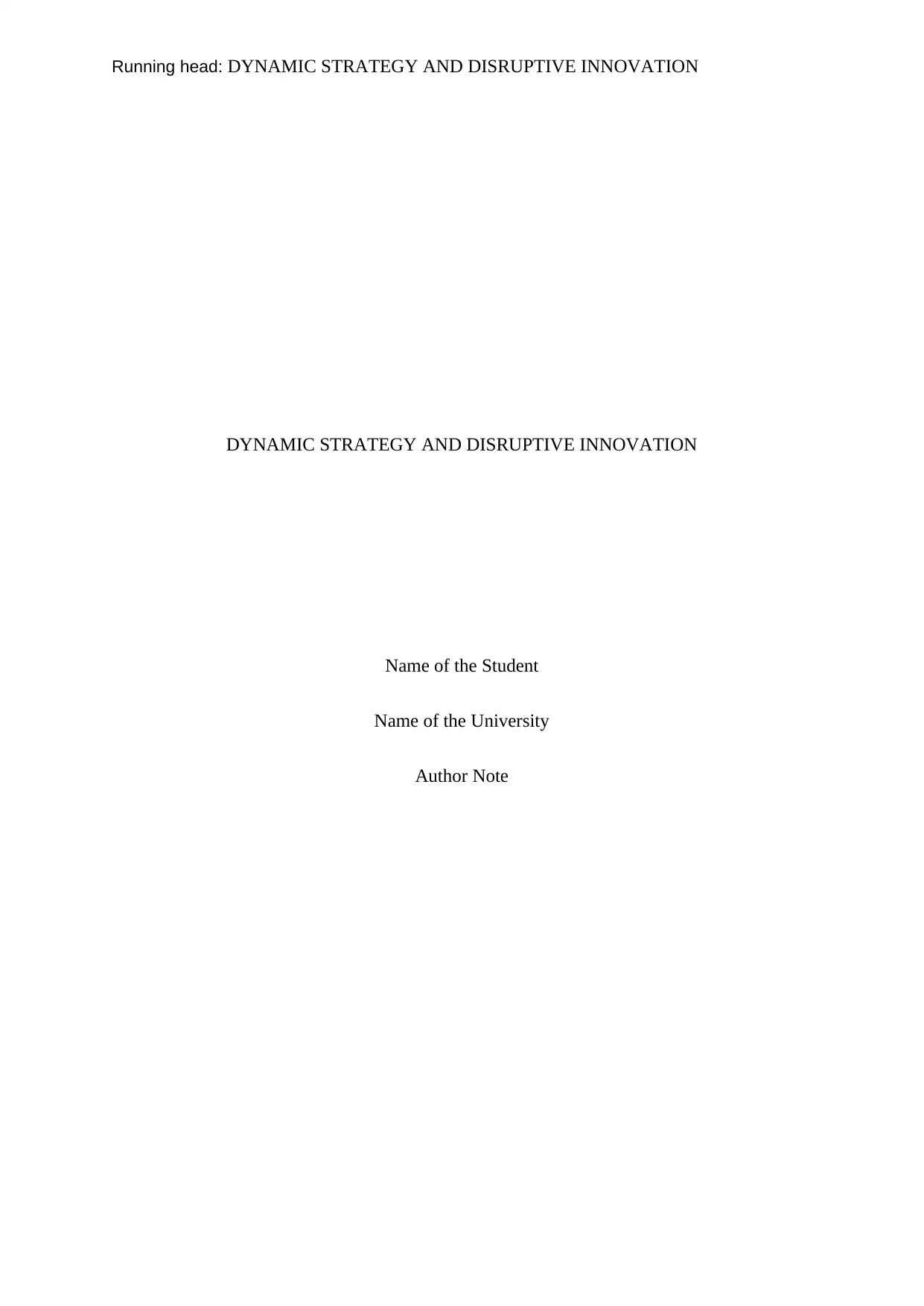
Running head: DYNAMIC STRATEGY AND DISRUPTIVE INNOVATION
DYNAMIC STRATEGY AND DISRUPTIVE INNOVATION
Name of the Student
Name of the University
Author Note
DYNAMIC STRATEGY AND DISRUPTIVE INNOVATION
Name of the Student
Name of the University
Author Note
Paraphrase This Document
Need a fresh take? Get an instant paraphrase of this document with our AI Paraphraser
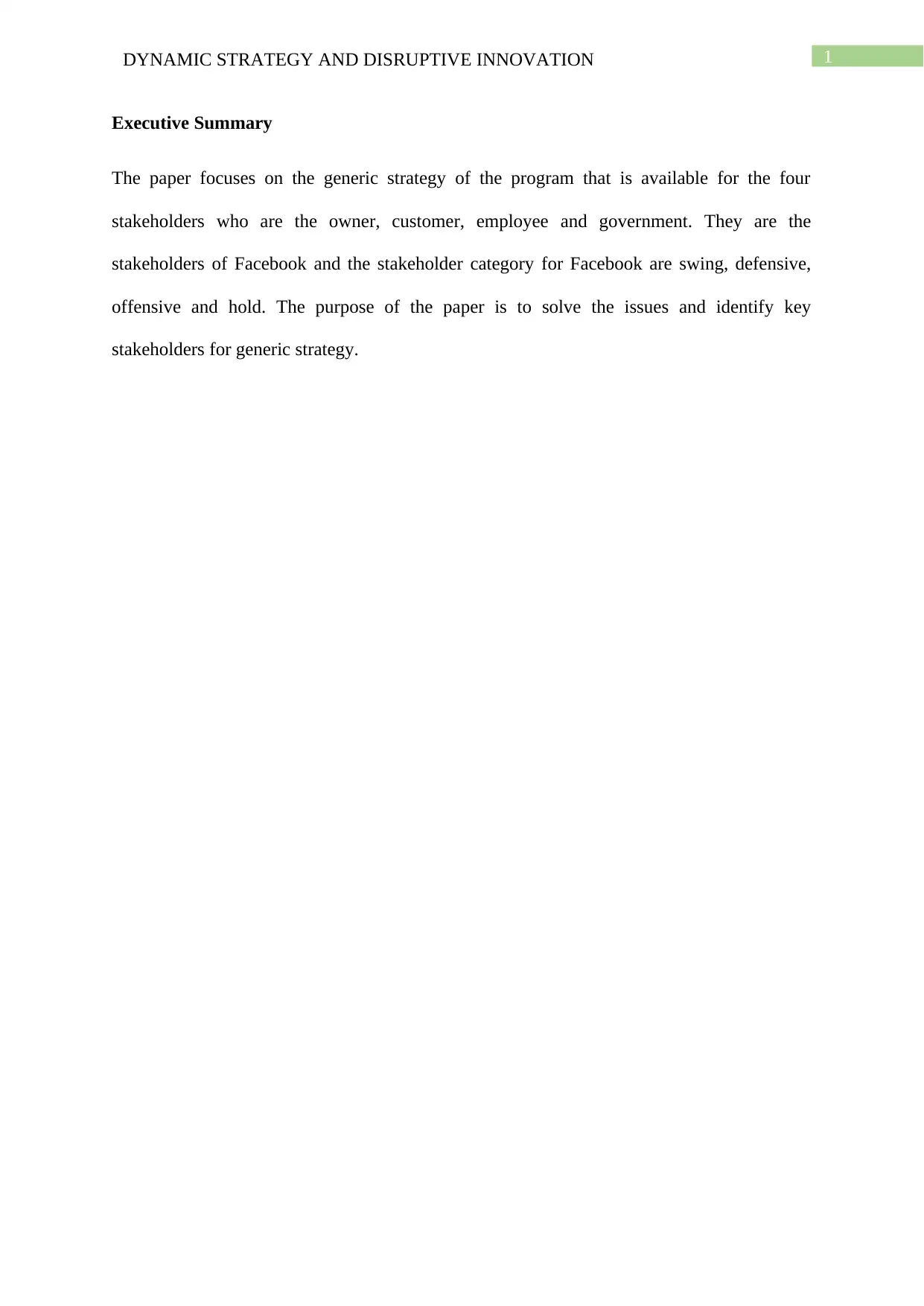
1DYNAMIC STRATEGY AND DISRUPTIVE INNOVATION
Executive Summary
The paper focuses on the generic strategy of the program that is available for the four
stakeholders who are the owner, customer, employee and government. They are the
stakeholders of Facebook and the stakeholder category for Facebook are swing, defensive,
offensive and hold. The purpose of the paper is to solve the issues and identify key
stakeholders for generic strategy.
Executive Summary
The paper focuses on the generic strategy of the program that is available for the four
stakeholders who are the owner, customer, employee and government. They are the
stakeholders of Facebook and the stakeholder category for Facebook are swing, defensive,
offensive and hold. The purpose of the paper is to solve the issues and identify key
stakeholders for generic strategy.
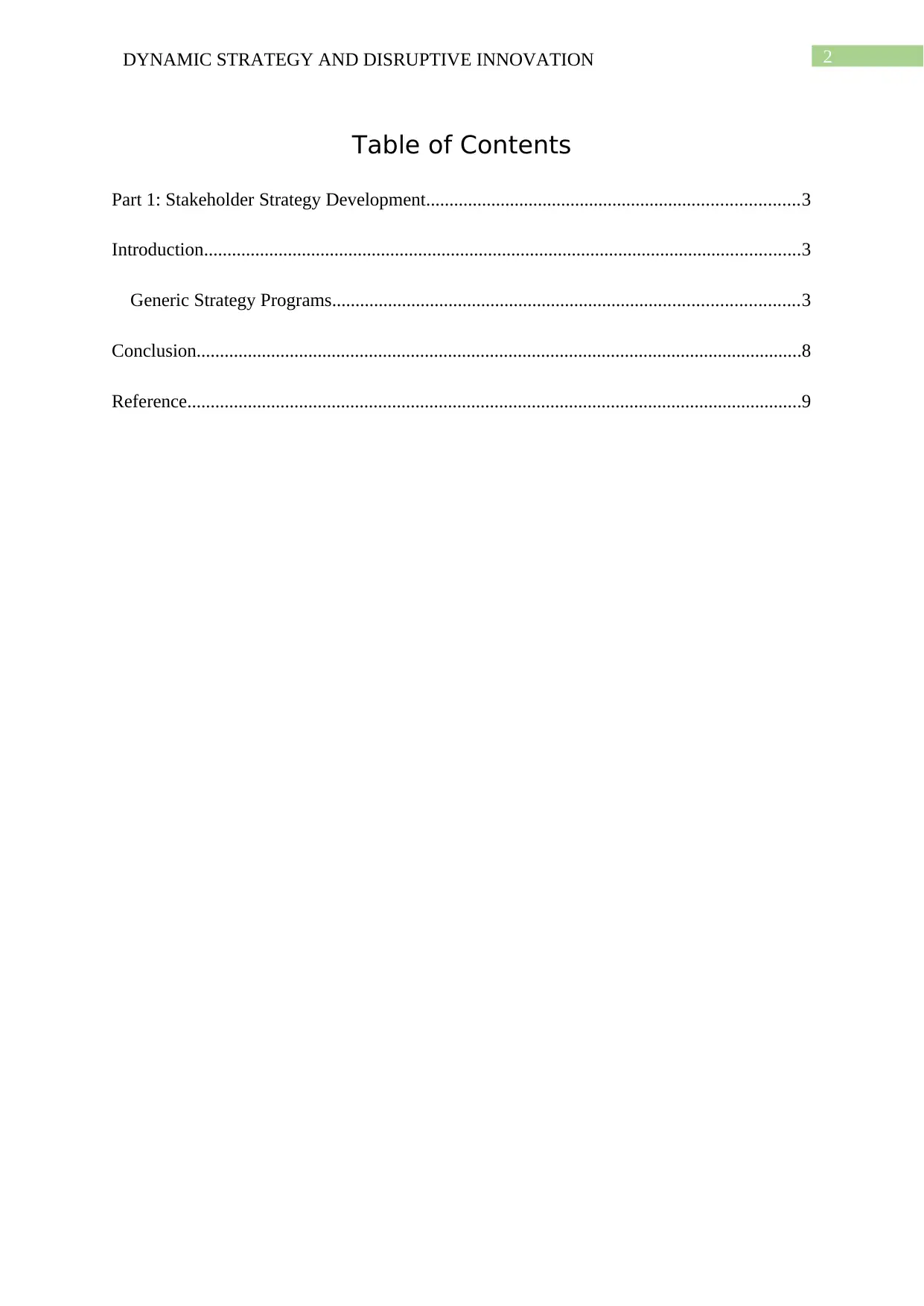
2DYNAMIC STRATEGY AND DISRUPTIVE INNOVATION
Table of Contents
Part 1: Stakeholder Strategy Development................................................................................3
Introduction................................................................................................................................3
Generic Strategy Programs....................................................................................................3
Conclusion..................................................................................................................................8
Reference....................................................................................................................................9
Table of Contents
Part 1: Stakeholder Strategy Development................................................................................3
Introduction................................................................................................................................3
Generic Strategy Programs....................................................................................................3
Conclusion..................................................................................................................................8
Reference....................................................................................................................................9
⊘ This is a preview!⊘
Do you want full access?
Subscribe today to unlock all pages.

Trusted by 1+ million students worldwide
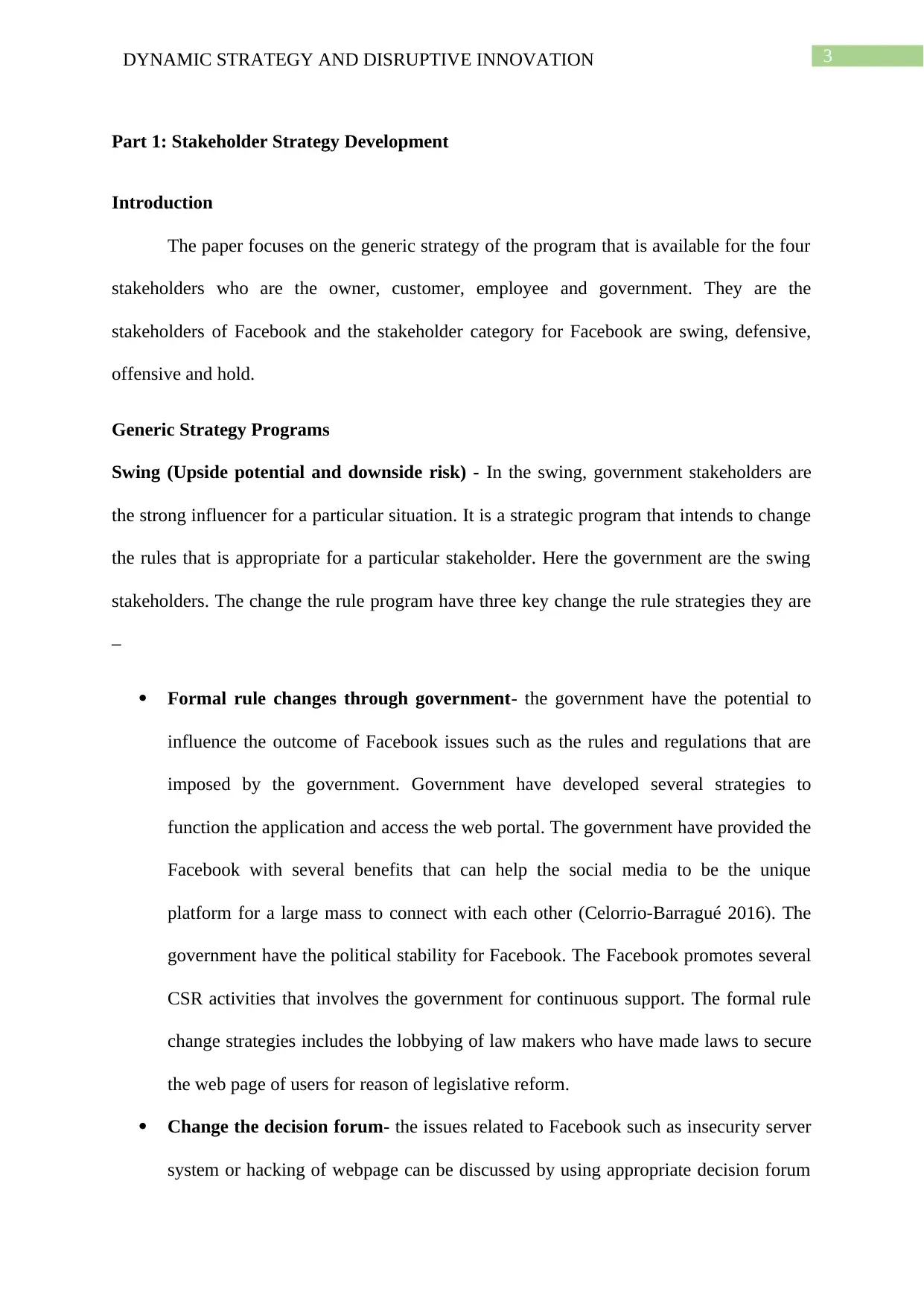
3DYNAMIC STRATEGY AND DISRUPTIVE INNOVATION
Part 1: Stakeholder Strategy Development
Introduction
The paper focuses on the generic strategy of the program that is available for the four
stakeholders who are the owner, customer, employee and government. They are the
stakeholders of Facebook and the stakeholder category for Facebook are swing, defensive,
offensive and hold.
Generic Strategy Programs
Swing (Upside potential and downside risk) - In the swing, government stakeholders are
the strong influencer for a particular situation. It is a strategic program that intends to change
the rules that is appropriate for a particular stakeholder. Here the government are the swing
stakeholders. The change the rule program have three key change the rule strategies they are
–
Formal rule changes through government- the government have the potential to
influence the outcome of Facebook issues such as the rules and regulations that are
imposed by the government. Government have developed several strategies to
function the application and access the web portal. The government have provided the
Facebook with several benefits that can help the social media to be the unique
platform for a large mass to connect with each other (Celorrio-Barragué 2016). The
government have the political stability for Facebook. The Facebook promotes several
CSR activities that involves the government for continuous support. The formal rule
change strategies includes the lobbying of law makers who have made laws to secure
the web page of users for reason of legislative reform.
Change the decision forum- the issues related to Facebook such as insecurity server
system or hacking of webpage can be discussed by using appropriate decision forum
Part 1: Stakeholder Strategy Development
Introduction
The paper focuses on the generic strategy of the program that is available for the four
stakeholders who are the owner, customer, employee and government. They are the
stakeholders of Facebook and the stakeholder category for Facebook are swing, defensive,
offensive and hold.
Generic Strategy Programs
Swing (Upside potential and downside risk) - In the swing, government stakeholders are
the strong influencer for a particular situation. It is a strategic program that intends to change
the rules that is appropriate for a particular stakeholder. Here the government are the swing
stakeholders. The change the rule program have three key change the rule strategies they are
–
Formal rule changes through government- the government have the potential to
influence the outcome of Facebook issues such as the rules and regulations that are
imposed by the government. Government have developed several strategies to
function the application and access the web portal. The government have provided the
Facebook with several benefits that can help the social media to be the unique
platform for a large mass to connect with each other (Celorrio-Barragué 2016). The
government have the political stability for Facebook. The Facebook promotes several
CSR activities that involves the government for continuous support. The formal rule
change strategies includes the lobbying of law makers who have made laws to secure
the web page of users for reason of legislative reform.
Change the decision forum- the issues related to Facebook such as insecurity server
system or hacking of webpage can be discussed by using appropriate decision forum
Paraphrase This Document
Need a fresh take? Get an instant paraphrase of this document with our AI Paraphraser
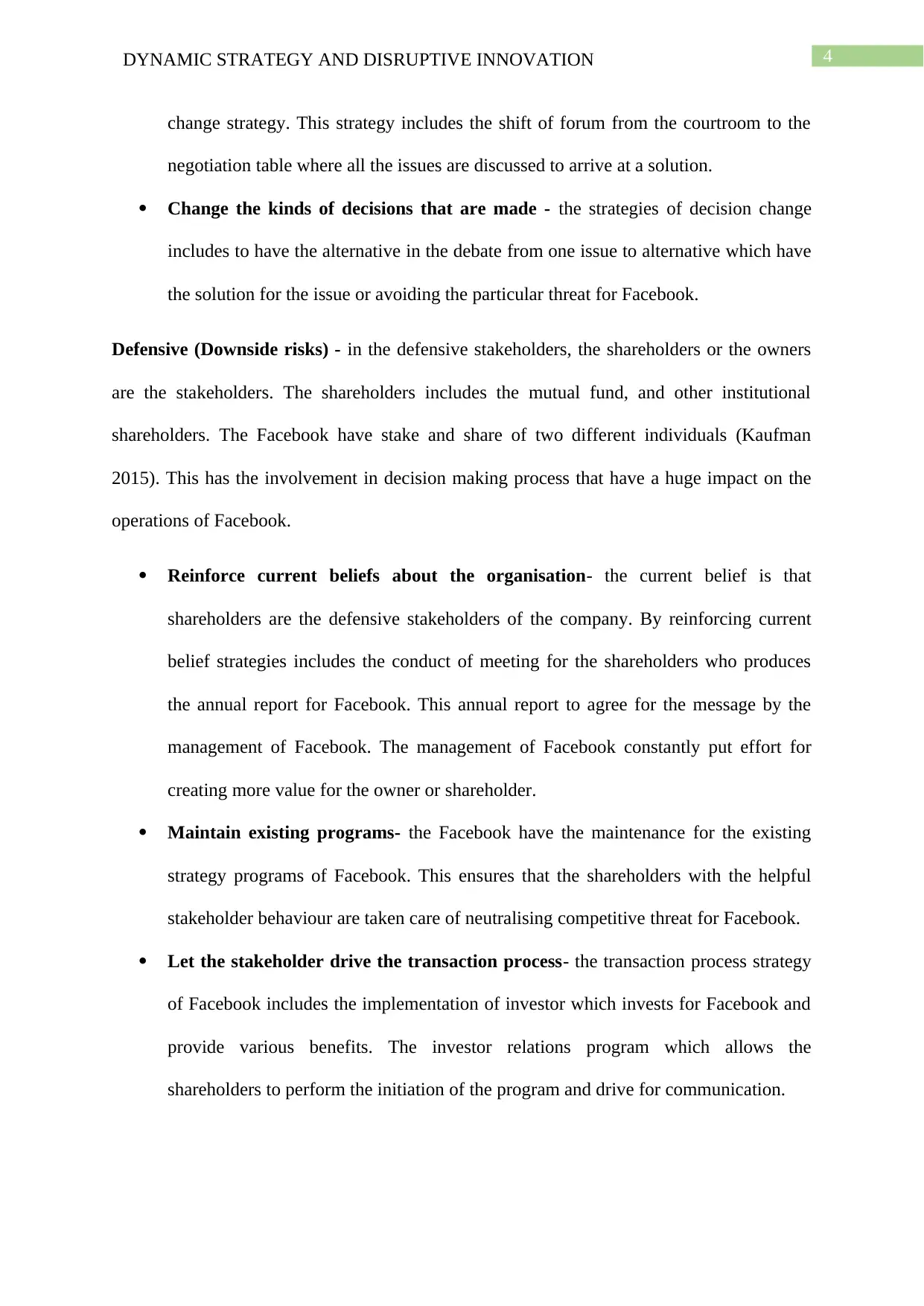
4DYNAMIC STRATEGY AND DISRUPTIVE INNOVATION
change strategy. This strategy includes the shift of forum from the courtroom to the
negotiation table where all the issues are discussed to arrive at a solution.
Change the kinds of decisions that are made - the strategies of decision change
includes to have the alternative in the debate from one issue to alternative which have
the solution for the issue or avoiding the particular threat for Facebook.
Defensive (Downside risks) - in the defensive stakeholders, the shareholders or the owners
are the stakeholders. The shareholders includes the mutual fund, and other institutional
shareholders. The Facebook have stake and share of two different individuals (Kaufman
2015). This has the involvement in decision making process that have a huge impact on the
operations of Facebook.
Reinforce current beliefs about the organisation- the current belief is that
shareholders are the defensive stakeholders of the company. By reinforcing current
belief strategies includes the conduct of meeting for the shareholders who produces
the annual report for Facebook. This annual report to agree for the message by the
management of Facebook. The management of Facebook constantly put effort for
creating more value for the owner or shareholder.
Maintain existing programs- the Facebook have the maintenance for the existing
strategy programs of Facebook. This ensures that the shareholders with the helpful
stakeholder behaviour are taken care of neutralising competitive threat for Facebook.
Let the stakeholder drive the transaction process- the transaction process strategy
of Facebook includes the implementation of investor which invests for Facebook and
provide various benefits. The investor relations program which allows the
shareholders to perform the initiation of the program and drive for communication.
change strategy. This strategy includes the shift of forum from the courtroom to the
negotiation table where all the issues are discussed to arrive at a solution.
Change the kinds of decisions that are made - the strategies of decision change
includes to have the alternative in the debate from one issue to alternative which have
the solution for the issue or avoiding the particular threat for Facebook.
Defensive (Downside risks) - in the defensive stakeholders, the shareholders or the owners
are the stakeholders. The shareholders includes the mutual fund, and other institutional
shareholders. The Facebook have stake and share of two different individuals (Kaufman
2015). This has the involvement in decision making process that have a huge impact on the
operations of Facebook.
Reinforce current beliefs about the organisation- the current belief is that
shareholders are the defensive stakeholders of the company. By reinforcing current
belief strategies includes the conduct of meeting for the shareholders who produces
the annual report for Facebook. This annual report to agree for the message by the
management of Facebook. The management of Facebook constantly put effort for
creating more value for the owner or shareholder.
Maintain existing programs- the Facebook have the maintenance for the existing
strategy programs of Facebook. This ensures that the shareholders with the helpful
stakeholder behaviour are taken care of neutralising competitive threat for Facebook.
Let the stakeholder drive the transaction process- the transaction process strategy
of Facebook includes the implementation of investor which invests for Facebook and
provide various benefits. The investor relations program which allows the
shareholders to perform the initiation of the program and drive for communication.
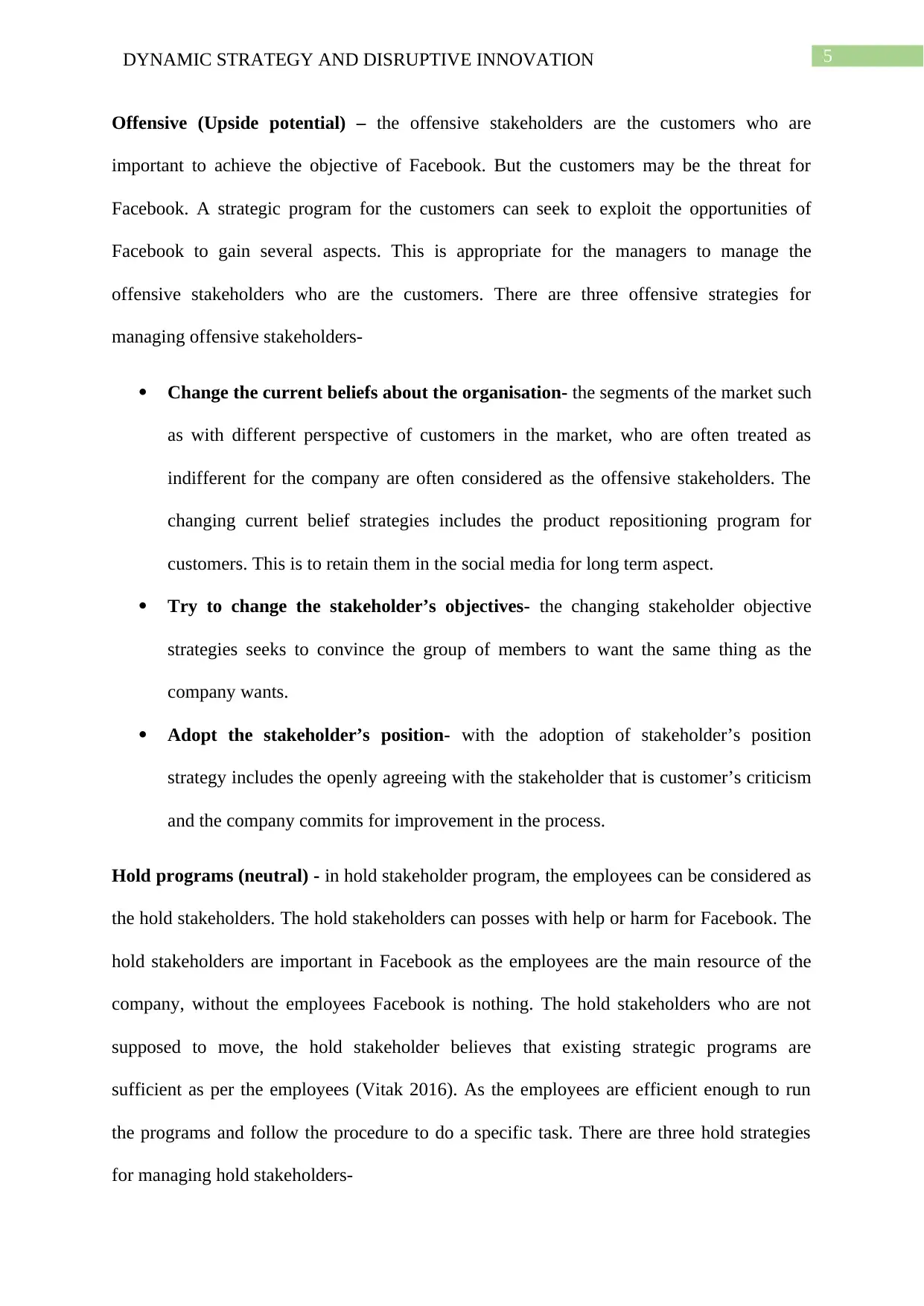
5DYNAMIC STRATEGY AND DISRUPTIVE INNOVATION
Offensive (Upside potential) – the offensive stakeholders are the customers who are
important to achieve the objective of Facebook. But the customers may be the threat for
Facebook. A strategic program for the customers can seek to exploit the opportunities of
Facebook to gain several aspects. This is appropriate for the managers to manage the
offensive stakeholders who are the customers. There are three offensive strategies for
managing offensive stakeholders-
Change the current beliefs about the organisation- the segments of the market such
as with different perspective of customers in the market, who are often treated as
indifferent for the company are often considered as the offensive stakeholders. The
changing current belief strategies includes the product repositioning program for
customers. This is to retain them in the social media for long term aspect.
Try to change the stakeholder’s objectives- the changing stakeholder objective
strategies seeks to convince the group of members to want the same thing as the
company wants.
Adopt the stakeholder’s position- with the adoption of stakeholder’s position
strategy includes the openly agreeing with the stakeholder that is customer’s criticism
and the company commits for improvement in the process.
Hold programs (neutral) - in hold stakeholder program, the employees can be considered as
the hold stakeholders. The hold stakeholders can posses with help or harm for Facebook. The
hold stakeholders are important in Facebook as the employees are the main resource of the
company, without the employees Facebook is nothing. The hold stakeholders who are not
supposed to move, the hold stakeholder believes that existing strategic programs are
sufficient as per the employees (Vitak 2016). As the employees are efficient enough to run
the programs and follow the procedure to do a specific task. There are three hold strategies
for managing hold stakeholders-
Offensive (Upside potential) – the offensive stakeholders are the customers who are
important to achieve the objective of Facebook. But the customers may be the threat for
Facebook. A strategic program for the customers can seek to exploit the opportunities of
Facebook to gain several aspects. This is appropriate for the managers to manage the
offensive stakeholders who are the customers. There are three offensive strategies for
managing offensive stakeholders-
Change the current beliefs about the organisation- the segments of the market such
as with different perspective of customers in the market, who are often treated as
indifferent for the company are often considered as the offensive stakeholders. The
changing current belief strategies includes the product repositioning program for
customers. This is to retain them in the social media for long term aspect.
Try to change the stakeholder’s objectives- the changing stakeholder objective
strategies seeks to convince the group of members to want the same thing as the
company wants.
Adopt the stakeholder’s position- with the adoption of stakeholder’s position
strategy includes the openly agreeing with the stakeholder that is customer’s criticism
and the company commits for improvement in the process.
Hold programs (neutral) - in hold stakeholder program, the employees can be considered as
the hold stakeholders. The hold stakeholders can posses with help or harm for Facebook. The
hold stakeholders are important in Facebook as the employees are the main resource of the
company, without the employees Facebook is nothing. The hold stakeholders who are not
supposed to move, the hold stakeholder believes that existing strategic programs are
sufficient as per the employees (Vitak 2016). As the employees are efficient enough to run
the programs and follow the procedure to do a specific task. There are three hold strategies
for managing hold stakeholders-
⊘ This is a preview!⊘
Do you want full access?
Subscribe today to unlock all pages.

Trusted by 1+ million students worldwide
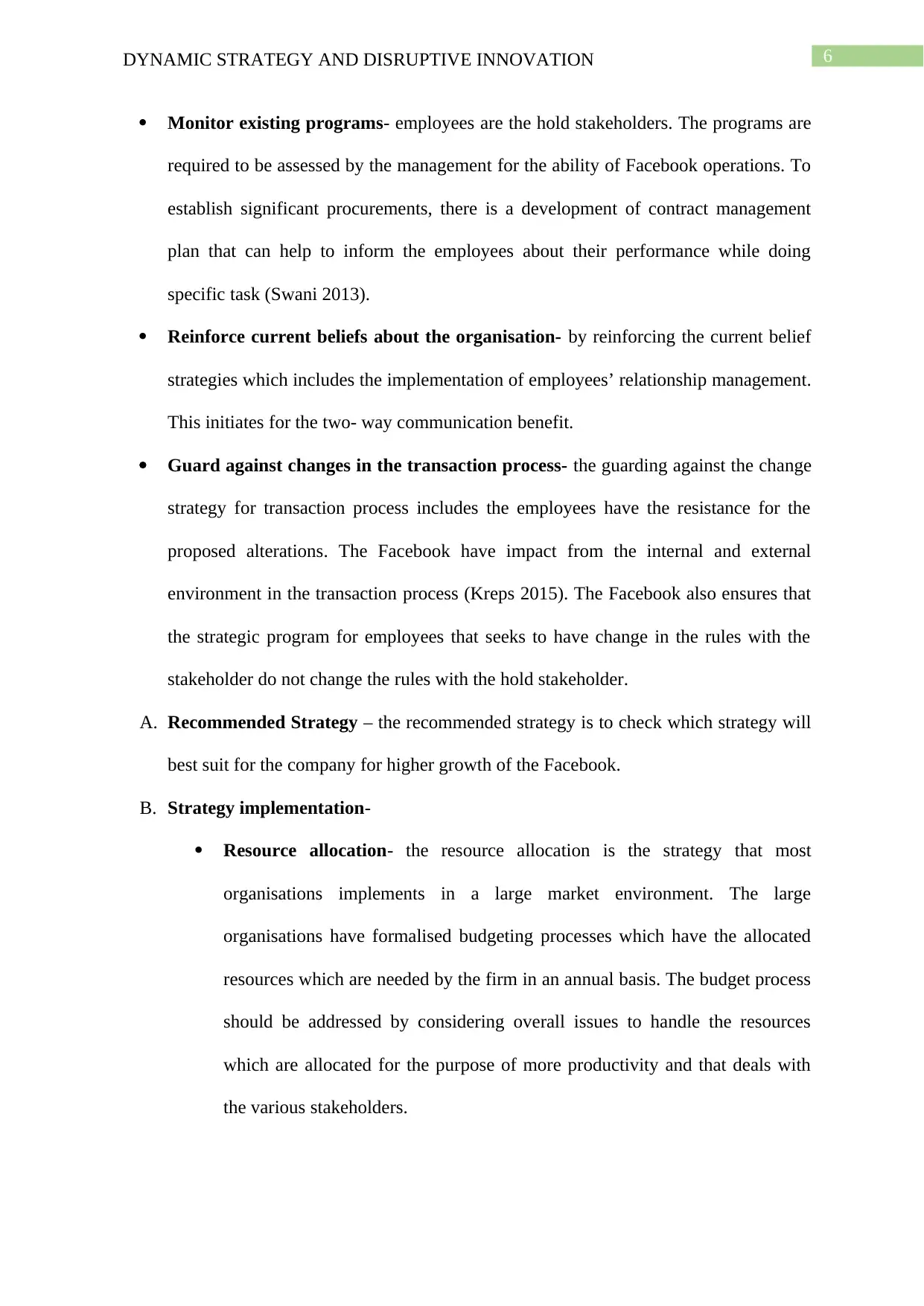
6DYNAMIC STRATEGY AND DISRUPTIVE INNOVATION
Monitor existing programs- employees are the hold stakeholders. The programs are
required to be assessed by the management for the ability of Facebook operations. To
establish significant procurements, there is a development of contract management
plan that can help to inform the employees about their performance while doing
specific task (Swani 2013).
Reinforce current beliefs about the organisation- by reinforcing the current belief
strategies which includes the implementation of employees’ relationship management.
This initiates for the two- way communication benefit.
Guard against changes in the transaction process- the guarding against the change
strategy for transaction process includes the employees have the resistance for the
proposed alterations. The Facebook have impact from the internal and external
environment in the transaction process (Kreps 2015). The Facebook also ensures that
the strategic program for employees that seeks to have change in the rules with the
stakeholder do not change the rules with the hold stakeholder.
A. Recommended Strategy – the recommended strategy is to check which strategy will
best suit for the company for higher growth of the Facebook.
B. Strategy implementation-
Resource allocation- the resource allocation is the strategy that most
organisations implements in a large market environment. The large
organisations have formalised budgeting processes which have the allocated
resources which are needed by the firm in an annual basis. The budget process
should be addressed by considering overall issues to handle the resources
which are allocated for the purpose of more productivity and that deals with
the various stakeholders.
Monitor existing programs- employees are the hold stakeholders. The programs are
required to be assessed by the management for the ability of Facebook operations. To
establish significant procurements, there is a development of contract management
plan that can help to inform the employees about their performance while doing
specific task (Swani 2013).
Reinforce current beliefs about the organisation- by reinforcing the current belief
strategies which includes the implementation of employees’ relationship management.
This initiates for the two- way communication benefit.
Guard against changes in the transaction process- the guarding against the change
strategy for transaction process includes the employees have the resistance for the
proposed alterations. The Facebook have impact from the internal and external
environment in the transaction process (Kreps 2015). The Facebook also ensures that
the strategic program for employees that seeks to have change in the rules with the
stakeholder do not change the rules with the hold stakeholder.
A. Recommended Strategy – the recommended strategy is to check which strategy will
best suit for the company for higher growth of the Facebook.
B. Strategy implementation-
Resource allocation- the resource allocation is the strategy that most
organisations implements in a large market environment. The large
organisations have formalised budgeting processes which have the allocated
resources which are needed by the firm in an annual basis. The budget process
should be addressed by considering overall issues to handle the resources
which are allocated for the purpose of more productivity and that deals with
the various stakeholders.
Paraphrase This Document
Need a fresh take? Get an instant paraphrase of this document with our AI Paraphraser
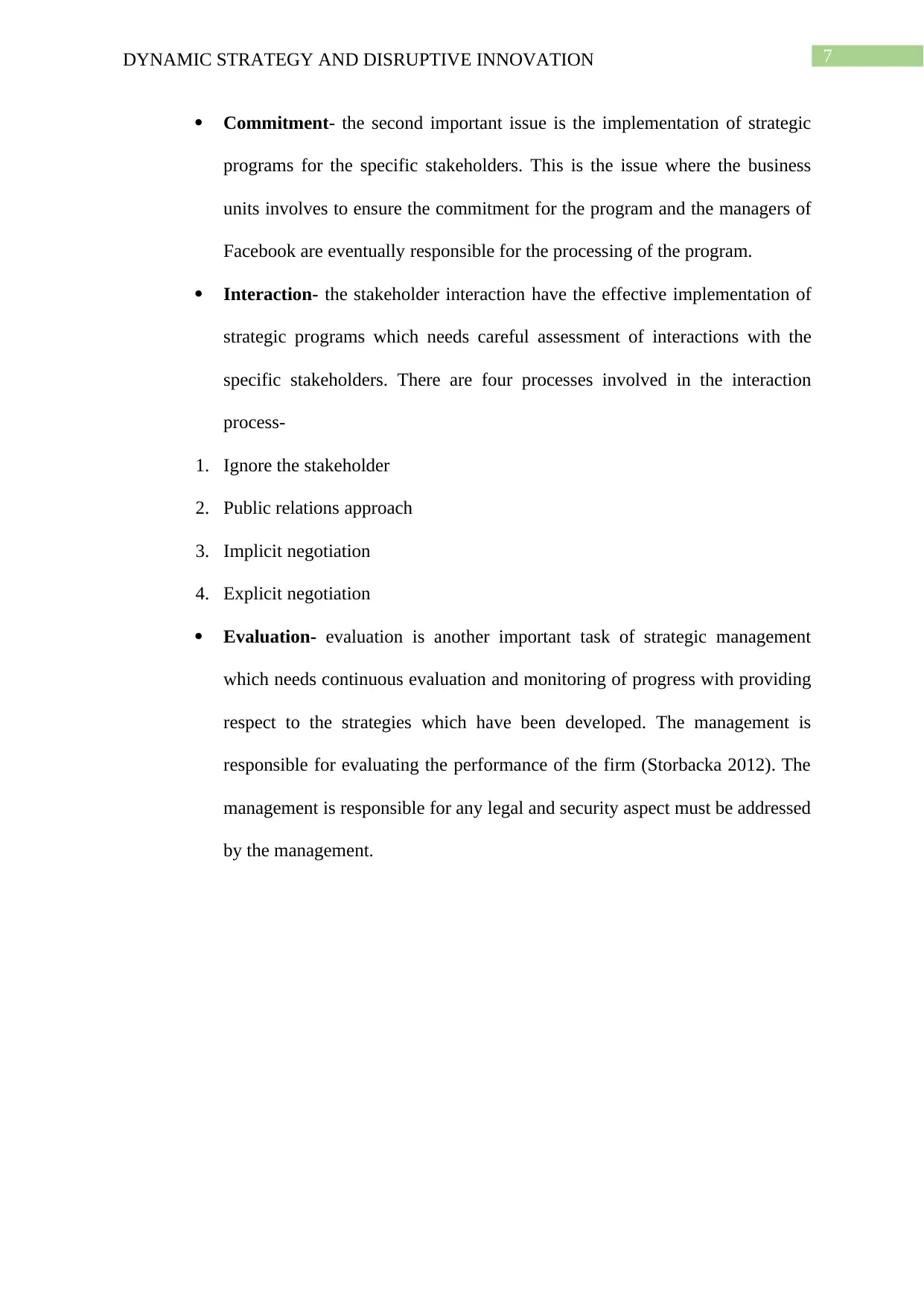
7DYNAMIC STRATEGY AND DISRUPTIVE INNOVATION
Commitment- the second important issue is the implementation of strategic
programs for the specific stakeholders. This is the issue where the business
units involves to ensure the commitment for the program and the managers of
Facebook are eventually responsible for the processing of the program.
Interaction- the stakeholder interaction have the effective implementation of
strategic programs which needs careful assessment of interactions with the
specific stakeholders. There are four processes involved in the interaction
process-
1. Ignore the stakeholder
2. Public relations approach
3. Implicit negotiation
4. Explicit negotiation
Evaluation- evaluation is another important task of strategic management
which needs continuous evaluation and monitoring of progress with providing
respect to the strategies which have been developed. The management is
responsible for evaluating the performance of the firm (Storbacka 2012). The
management is responsible for any legal and security aspect must be addressed
by the management.
Commitment- the second important issue is the implementation of strategic
programs for the specific stakeholders. This is the issue where the business
units involves to ensure the commitment for the program and the managers of
Facebook are eventually responsible for the processing of the program.
Interaction- the stakeholder interaction have the effective implementation of
strategic programs which needs careful assessment of interactions with the
specific stakeholders. There are four processes involved in the interaction
process-
1. Ignore the stakeholder
2. Public relations approach
3. Implicit negotiation
4. Explicit negotiation
Evaluation- evaluation is another important task of strategic management
which needs continuous evaluation and monitoring of progress with providing
respect to the strategies which have been developed. The management is
responsible for evaluating the performance of the firm (Storbacka 2012). The
management is responsible for any legal and security aspect must be addressed
by the management.
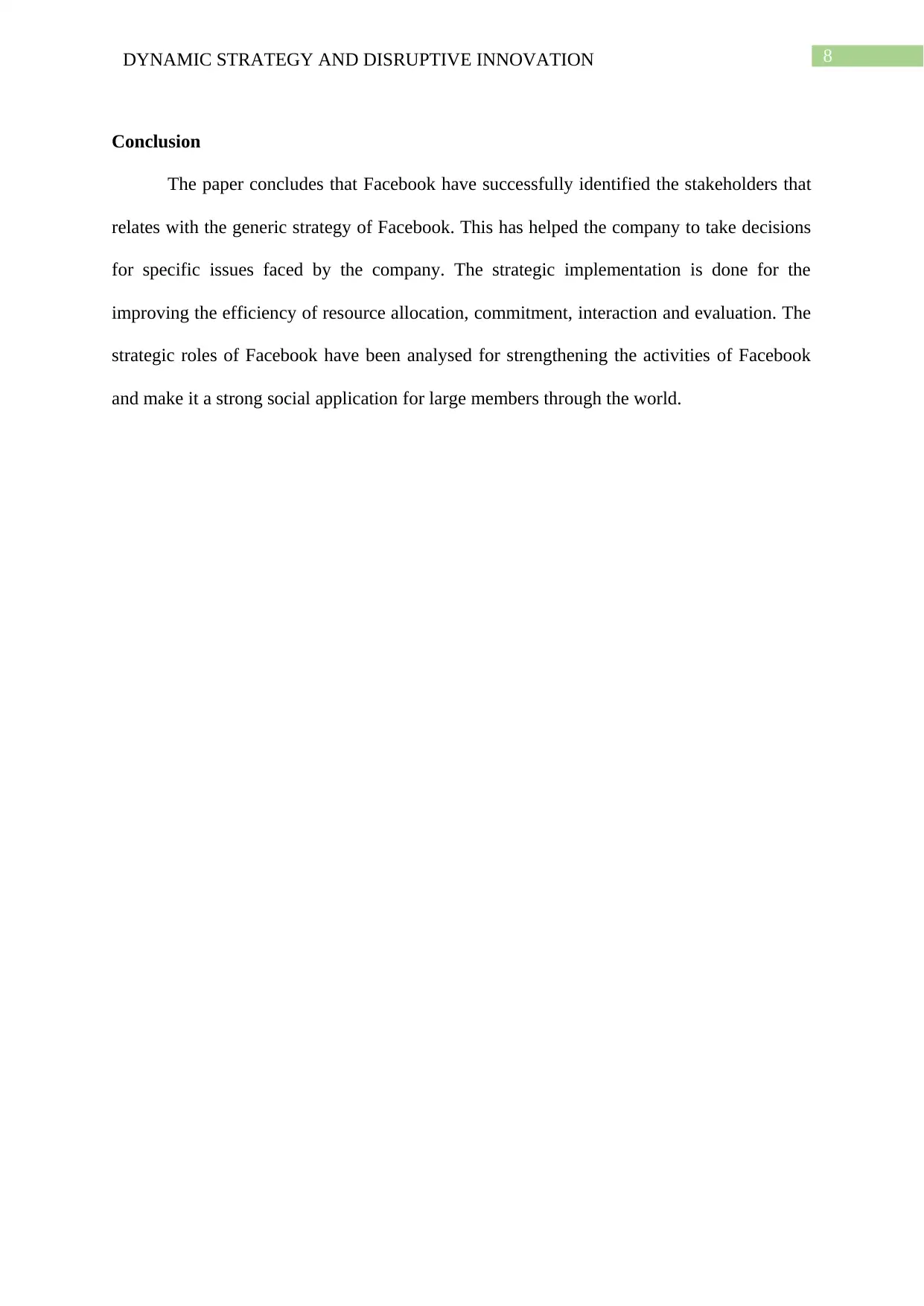
8DYNAMIC STRATEGY AND DISRUPTIVE INNOVATION
Conclusion
The paper concludes that Facebook have successfully identified the stakeholders that
relates with the generic strategy of Facebook. This has helped the company to take decisions
for specific issues faced by the company. The strategic implementation is done for the
improving the efficiency of resource allocation, commitment, interaction and evaluation. The
strategic roles of Facebook have been analysed for strengthening the activities of Facebook
and make it a strong social application for large members through the world.
Conclusion
The paper concludes that Facebook have successfully identified the stakeholders that
relates with the generic strategy of Facebook. This has helped the company to take decisions
for specific issues faced by the company. The strategic implementation is done for the
improving the efficiency of resource allocation, commitment, interaction and evaluation. The
strategic roles of Facebook have been analysed for strengthening the activities of Facebook
and make it a strong social application for large members through the world.
⊘ This is a preview!⊘
Do you want full access?
Subscribe today to unlock all pages.

Trusted by 1+ million students worldwide
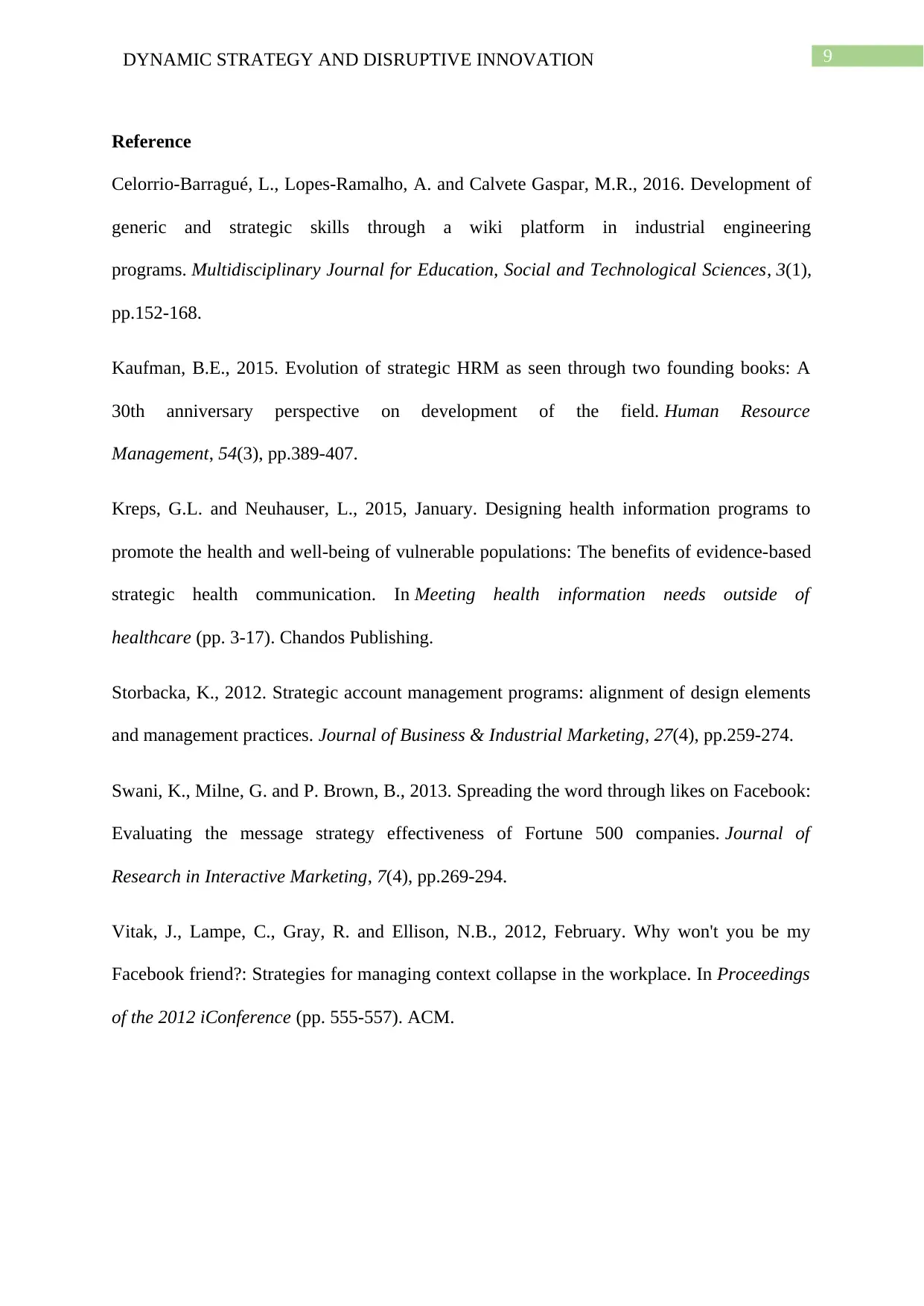
9DYNAMIC STRATEGY AND DISRUPTIVE INNOVATION
Reference
Celorrio-Barragué, L., Lopes-Ramalho, A. and Calvete Gaspar, M.R., 2016. Development of
generic and strategic skills through a wiki platform in industrial engineering
programs. Multidisciplinary Journal for Education, Social and Technological Sciences, 3(1),
pp.152-168.
Kaufman, B.E., 2015. Evolution of strategic HRM as seen through two founding books: A
30th anniversary perspective on development of the field. Human Resource
Management, 54(3), pp.389-407.
Kreps, G.L. and Neuhauser, L., 2015, January. Designing health information programs to
promote the health and well-being of vulnerable populations: The benefits of evidence-based
strategic health communication. In Meeting health information needs outside of
healthcare (pp. 3-17). Chandos Publishing.
Storbacka, K., 2012. Strategic account management programs: alignment of design elements
and management practices. Journal of Business & Industrial Marketing, 27(4), pp.259-274.
Swani, K., Milne, G. and P. Brown, B., 2013. Spreading the word through likes on Facebook:
Evaluating the message strategy effectiveness of Fortune 500 companies. Journal of
Research in Interactive Marketing, 7(4), pp.269-294.
Vitak, J., Lampe, C., Gray, R. and Ellison, N.B., 2012, February. Why won't you be my
Facebook friend?: Strategies for managing context collapse in the workplace. In Proceedings
of the 2012 iConference (pp. 555-557). ACM.
Reference
Celorrio-Barragué, L., Lopes-Ramalho, A. and Calvete Gaspar, M.R., 2016. Development of
generic and strategic skills through a wiki platform in industrial engineering
programs. Multidisciplinary Journal for Education, Social and Technological Sciences, 3(1),
pp.152-168.
Kaufman, B.E., 2015. Evolution of strategic HRM as seen through two founding books: A
30th anniversary perspective on development of the field. Human Resource
Management, 54(3), pp.389-407.
Kreps, G.L. and Neuhauser, L., 2015, January. Designing health information programs to
promote the health and well-being of vulnerable populations: The benefits of evidence-based
strategic health communication. In Meeting health information needs outside of
healthcare (pp. 3-17). Chandos Publishing.
Storbacka, K., 2012. Strategic account management programs: alignment of design elements
and management practices. Journal of Business & Industrial Marketing, 27(4), pp.259-274.
Swani, K., Milne, G. and P. Brown, B., 2013. Spreading the word through likes on Facebook:
Evaluating the message strategy effectiveness of Fortune 500 companies. Journal of
Research in Interactive Marketing, 7(4), pp.269-294.
Vitak, J., Lampe, C., Gray, R. and Ellison, N.B., 2012, February. Why won't you be my
Facebook friend?: Strategies for managing context collapse in the workplace. In Proceedings
of the 2012 iConference (pp. 555-557). ACM.
1 out of 10
Related Documents
Your All-in-One AI-Powered Toolkit for Academic Success.
+13062052269
info@desklib.com
Available 24*7 on WhatsApp / Email
![[object Object]](/_next/static/media/star-bottom.7253800d.svg)
Unlock your academic potential
Copyright © 2020–2025 A2Z Services. All Rights Reserved. Developed and managed by ZUCOL.





